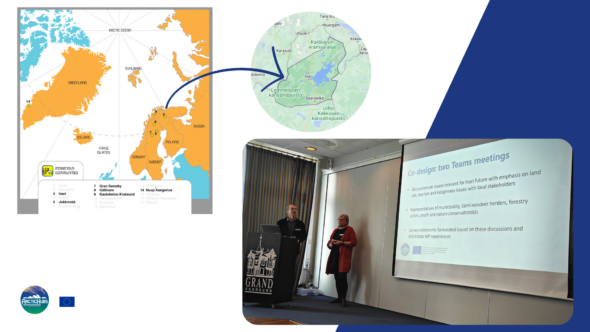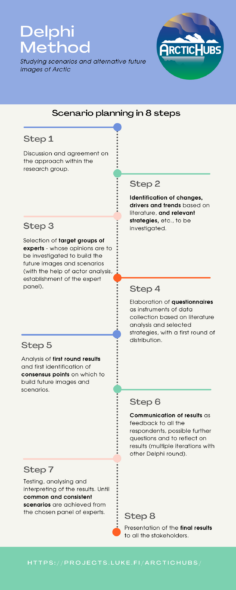Different interests, geopolitical plans and socio-economic activities are leading to many challenges in Arctic land use management. There are already guidelines and legal norms for improving participation and decision-making processes on land-use planning for Arctic Countries, such as in Finland. But still the effectiveness of participation vary a lot, and Arctic land use is under great pressure nowadays.
As part of the project research, different in-depth analytical research methods are being used and tested to assess understanding of land use conflict, areas and issues over land, trends and mega trends impacting the Arctic, local stakeholders, policy makers and citizens’ perceptions, and to identify future development opportunities and choices.
Pasi Rikkonen, research professor at the Natural Resources Institute Finland (Luke) and researcher for ArcticHubs project explains us briefly what is Delphi and why it has been chosen among the ArcticHubs research tools. Together with Seija Tuulentie, research professor at Luke and ArcticHubs WP5 leader, they have been utilising the Delphi method in one of the hubs of the project, Inari, in Finland, and since this year and our last Annual Meeting (September 2022), they have started helping project partners to ensure they can confidently apply Delphi method in other hubs’ research.

What is Delphi methodology?
The Delphi is a research method that concentrates on assessing and forecasting the future. The users of the Delphi technique aim to explore alternative future images, possibilities, their probabilities of occurrence, and their desirability by tapping the expertise of respondents (Linstone and Turoff 1975).
The Delphi method consists of the analysis of experts’ judgement by means of successive iterations of a given questionnaire, to identify and show convergence of opinions and dissent, or non-convergence.
Foresight research, such as Delphi based research, has an essential role to play in opening up research led and practice-based solutions to the challenges affecting the Arctic.
Looking for alternative to build possible future scenarios
1) Anonymity and 2) feedback can be considered as two irreducible elements of a Delphi technique. Traditionally, a third feature, a consensus seeking, has been one key element of this method. However, especially as a result of criticism over the decades, the consensus principle has been redefined (more Rikkonen 2005). In fact, in current Delphi processes the final outcome – a possible future scenario – is usually constructed as alternative scenarios. The consensus seeking is not a key aim any more. We also have a lot of literature about using Delphi as a consensus method or using it as a dissensus method.
The idea is that if we are interested in one future (a desired vision) Delphi can be used to iterate rounds in achieving consensus on that – however, today we are more interested about potential futures (desirable, probable, feasible, etc.) and therefore the different future images that respondents have are sources for alternative scenarios.
Establishing a panel of experts
The method for selecting the Delphi panel of expert is also one of the most critical phases of any Delphi investigation. The Delphi facilitator should consider in his/her initial actor analysis the most important stakeholders, the competence of experts chosen, as well as the terms of delivering information in a Delphi process (information policy). Plus, the selection process of an expert panel should be done as explicit and transparent as possible.
What are the main step of Delphi? And key elements?
The infographic below summarises in eight steps a Delphi investigation, including the construction of alternative future scenarios.

How and why is it chosen as an appropriate method for ArcticHubs project?
It suits well on assessing future developments of Arctic hubs and helps us to discuss the desirable, probable and feasible futures as they are in the minds and opinions of different stakeholders and interest groups, to forecasting land use problems whose solutions are not yet determined.
The Delphi’s relevance to project aims is also that of
generating future information and based on that the opportunity to generate interaction with local, regional and national stakeholders and interest groups.
What are the pros and cons of applying this research methodology?
Pros: how to apply the method is quite flexible, plus the method takes into account an extensive variety of future views
Cons: can be laborious, if aim is an extensive study!
Thinking of the ArcticHubs, where have you been using and what are the first insights coming from its use?
We have been using it for the Inari Hub case study ongoing and the four first steps of Delphi are now sufficiently done there. Let’s discuss our experiences as we proceed with future study of Inari Hub.
References
Linstone, H.A. & Turoff, M. 1975. The Delphi method: Techniques and applications. Available: https://web.njit.edu/~turoff/pubs/delphibook/index.html
Rikkonen, Pasi; Tapio, Petri; Rintamäki, Heidi. 2019. Visions for small-scale renewable energy production on Finnish farms – A Delphi study on the opportunities for new business. Energy Policy 129: 939-948.
Rikkonen, Pasi; Tapio, Petri. 2009. Future prospects of alternative agro-based bioenergy use in Finland – constructing scenarios with quantitative and qualitative delphi data. Technological forecasting and social change 76 7: 978-990.
Rikkonen, Pasi. 2005. Scenarios for future agriculture in Finland: a Delphi study among agri-food sector stakeholders. Agricultural and Food Science 14 3: 205-223.
